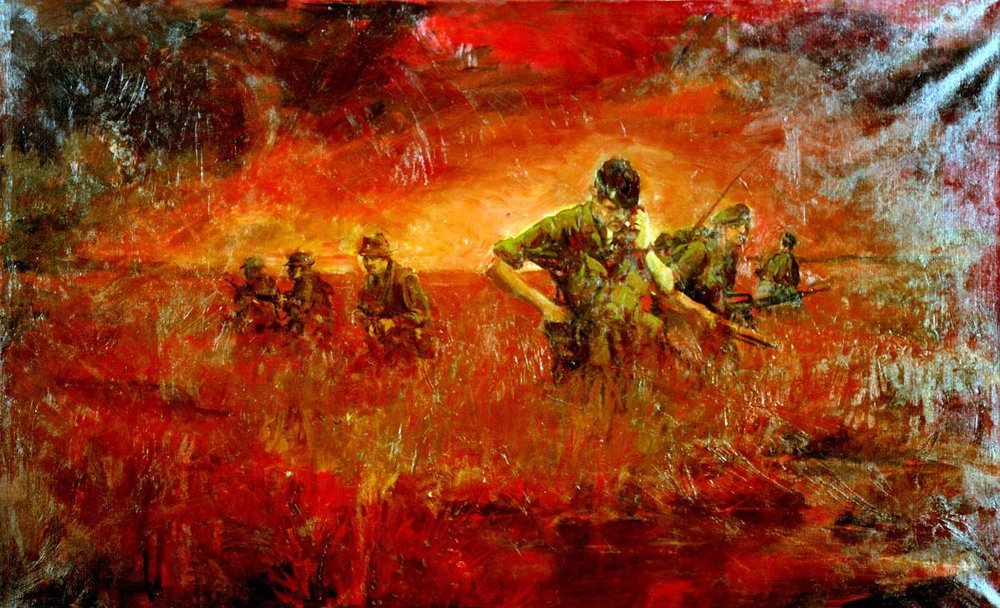Drawn to Battle: The Healing Impact of Vietnam War Art
“The war against Vietnam is only the ghastliest manifestation of what I’d call imperial provincialism, which afflicts America’s whole culture — aware only of its own history, insensible to everything which isn’t part of the local atmosphere.”
— STEPHEN VIZINCZEY- LONDON TIMES, 1968
What would it be like to sit still and pencil a drawing in the middle of a warzone? Dropping your sketch pad to pick up an M16 assault rifle and exchange gunfire with an enemy soldier. Then in another instance tossing your paintbrush to dodge high caliber bullets whizzing overhead.
This was the reality for many soldiers in 1966. The year the United States Army began its combat arts program during the Vietnam war.
The war in Vietnam was filthy, not only for the swampy terrain of the country, but for the civilian casualties. Collateral damage deaths are a grim reality of any war. But the estimated 365,000 innocent Vietnamese civilians bombed and massacred left an unbearably bitter taste in the mouths of the American public.
The nation grew woozy of war. Resentful of it. That sentiment swelled. Then finally after 20 years America withdrew it’s troops. But when the Vietnam war art program signed it’s first combat artists in 1966 there was much more war to be fought.
The combat arts program had 9 teams of 5 artists who rotated into the field over several years. They sketched they drew, and they painted. Unleashing raw emotion and a stunning visual history a soldiers life. Each artist brought a unique perspective. Stylistically varied yet together each individual art piece forms a cohesive montage of war.
The artists covered a wide range of subject matter. In one painting vivid reds and brilliant oranges pop out as the backdrop for 6 U.S soldiers. They seem to move forward unfazed while navigating the blistering inferno. Contrast this with another where a soldier sits for a haircut. Through the art you get a sense of the fighting and the daily life of the American soldier and the local Vietnamese civilians they encountered. The irony of war has always been this. Mass atrocities are carried out by people with the capacity for genuine humanity and generosity. The artist convey this with deft skill.
"Man/Ready, Vietnam”
"Man/Ready, Vietnam” by Paul MAC Wiliams. RG 330, Records of the Office of the Secretary of Defense, 1921-2008
The paintings are engaging because they invite the viewer to seek out their meaning. They force you to think about what the artist is trying to say.
Kristopher Battles, a Marine combat artist who reenlisted for active duty specifically to participate in the combat artist program, gave us this perspective on what makes combat art unique:
“Every artist has a totally different machine, a totally different mind, a totally different software...so they are seeing it differently,” Battles said. “If you give 5 Marines a Pentax (camera), it’s the same exact machinery. Whereas with humans, artistically there’s a whole lot of difference... there’s more of a range of experience and it comes through this physical act of putting it on paper”
Medcap, Vietnam”
"Medcap, Vietnam” by Herbert Brady, 1970. RG 330, Records of the Office of the Secretary of Defense, 1921-2008
“The idea of rotating teams of young soldier-artists from a variety of backgrounds and experiences through Vietnam was innovative. What was even more remarkable is that these soldier-artists were encouraged to freely express and interpret their individual experience in their own distinct styles. The artists responded enthusiastically to their artistic free reign, and the resulting products were wide ranging and comprehensive.
Styles and media used were as diverse as the artists themselves, some chose detailed literal images while others preferred expressive almost abstract explosions striving to replicate the horrors of war. Certainly, a lasting legacy of the army’s soldier art program is that it helped bring military art into the modern era.
One of the pieces I did was a 1st Infantry Division soldier receiving a field haircut. At the time I thought it unusual for a soldier to be getting a haircut in the middle of the jungle, so I sketched the scene and later made a watercolor and ink painting it.
I feel that each soldier art team is like a block of a quilt and each artist on each team produced a distinct individual pattern that contributed to that particular block. While each block and each pattern can be considered a work of art in itself, it is when blocks are stitched together and we see the entire blanket that a new work of art reveals itself. This new work of art becomes greater in significance than the sum of its pieces, so it is with these nine soldier art teams. Finding and stitching these pieces together into a comprehensive overview of the army’s soldier
art program is what I’ve tried to do. ”
— JAMES POLLOCK
These paintings & sketches are a unique part of history.
Raw portraits of what it was like to be at war. They put you there in a way that only art can.
Take some time to look at each piece. Its subject matter, shapes, color choices, and compositions. These elements were not chosen by accident, they were deliberately selected to portray a message. What does the art say to you about the war?
You can check out more from the combat art program over at the National Archives Catalog, and if you liked the article please share.
Chopper Pickup
Brian H. Clark Cat 07
POTABLE WATER by Michael P. Pala, 1968
ATTACK AT TWILIGHT
Roger Blum, CAT I, 1966
THE INNOCENT
Kenneth J. Scowcroft, CAT III, 1967
Members of the Civilian Regular Defense Group- Augustine G. Acuna, 1966







